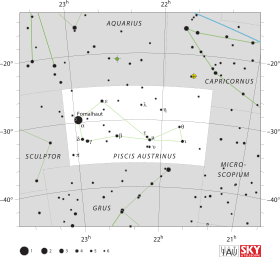Theta Piscis Austrini
Theta Piscis Austrini (θ Piscis Austrini) is a binary star[7] system in the southern constellation of Piscis Austrinus. It is faintly visible to the naked eye with a combined apparent visual magnitude of +5.01.[2] Based upon an annual parallax shift of 10.16 mas as seen from the Earth,[1] the system is located around 320 light years from the Sun.
 | |
| Observation data Epoch J2000.0 Equinox J2000.0 (ICRS) | |
|---|---|
| Constellation | Piscis Austrinus |
| Right ascension | 21h 47m 44.14993s[1] |
| Declination | −30° 53′ 53.9027″[1] |
| Apparent magnitude (V) | +5.01[2] |
| Characteristics | |
| Spectral type | A1 V + A1 V[3] |
| B−V color index | +0.04[2] |
| Astrometry | |
| Proper motion (μ) | RA: −34.40[1] mas/yr Dec.: −0.08[1] mas/yr |
| Parallax (π) | 10.16 ± 0.40[1] mas |
| Distance | 320 ± 10 ly (98 ± 4 pc) |
| Absolute magnitude (MV) | +0.06[4] |
| Orbit[3] | |
| Period (P) | 19.957±0.050 yr |
| Semi-major axis (a) | 0.137±0.004″ |
| Eccentricity (e) | 0.256±0.030 |
| Inclination (i) | 103±2° |
| Longitude of the node (Ω) | 29.1±2.0° |
| Periastron epoch (T) | 2006.00 ± 0.07 |
| Argument of periastron (ω) (secondary) | 199±6° |
| Details | |
| θ PsA A | |
| Mass | 2.32±0.33[3] M☉ |
| Luminosity | 86[4] L☉ |
| Surface gravity (log g) | 4.05[5] cgs |
| Temperature | 9,716±330[5] K |
| Rotational velocity (v sin i) | 150[5] km/s |
| Age | 281[5] Myr |
| θ PsA B | |
| Mass | 2.32±0.33[3] M☉ |
| Other designations | |
| Database references | |
| SIMBAD | data |
The binary nature of this system was discovered in 1951 by South African astronomer W. S. Finsen. Both components A and B have the same apparent magnitude. They orbit each other with a period of 20 years and an eccentricity of 0.256. The pair are A-type main sequence stars with stellar classifications of A1 V.[3] A magnitude 11.3 star, labelled component C, is located at an angular separation of 33.2 arc seconds along a position angle of 342°, as of 1999.[8]
Theta Piscis Austrini is moving through the Galaxy at a speed of 21.3 km/s relative to the Sun. Its projected Galactic orbit carries it between 22,600 and 38,300 light years from the center of the Galaxy. Theta Piscis Austrini came closest to the Sun 2.7 million years ago when it had brightened to magnitude 4.54 from a distance of 256 light years.[9]
Naming
In Chinese, 天錢 (Tiān Qián), meaning Celestial Money, refers to an asterism consisting of refers to an asterism consisting of θ Piscis Austrini, 13 Piscis Austrini, ι Piscis Austrini, μ Piscis Austrini and τ Piscis Austrini. Consequently, the Chinese name for θ Piscis Austrini itself is 天錢二 (Tiān Qián èr, English: the Second Star of Celestial Money.)[10]
References
- van Leeuwen, F. (2007), "Validation of the new Hipparcos reduction", Astronomy and Astrophysics, 474 (2): 653–664, arXiv:0708.1752, Bibcode:2007A&A...474..653V, doi:10.1051/0004-6361:20078357.
- Nicolet, B. (1978), "Photoelectric photometric Catalogue of homogeneous measurements in the UBV System", Astronomy and Astrophysics Supplement Series, 34: 1–49, Bibcode:1978A&AS...34....1N.
- Docobo, J. A.; Andrade, M. (2013), "Dynamical and physical properties of 22 binaries discovered by W. S. Finsen", Monthly Notices of the Royal Astronomical Society, 428 (1): 321–339, Bibcode:2013MNRAS.428..321D, doi:10.1093/mnras/sts045.
- Anderson, E.; Francis, Ch. (2012), "XHIP: An extended hipparcos compilation", Astronomy Letters, 38 (5): 331, arXiv:1108.4971, Bibcode:2012AstL...38..331A, doi:10.1134/S1063773712050015.
- David, Trevor J.; Hillenbrand, Lynne A. (2015), "The Ages of Early-Type Stars: Strömgren Photometric Methods Calibrated, Validated, Tested, and Applied to Hosts and Prospective Hosts of Directly Imaged Exoplanets", The Astrophysical Journal, 804 (2): 146, arXiv:1501.03154, Bibcode:2015ApJ...804..146D, doi:10.1088/0004-637X/804/2/146.
- "tet PsA -- Double or multiple star", SIMBAD Astronomical Database, Centre de Données astronomiques de Strasbourg, retrieved 2017-05-18.
- Eggleton, P. P.; Tokovinin, A. A. (September 2008), "A catalogue of multiplicity among bright stellar systems", Monthly Notices of the Royal Astronomical Society, 389 (2): 869–879, arXiv:0806.2878, Bibcode:2008MNRAS.389..869E, doi:10.1111/j.1365-2966.2008.13596.x.
- Mason, B. D.; et al. (2014), The Washington Visual Double Star Catalog, Bibcode:2001AJ....122.3466M, doi:10.1086/323920, retrieved 2015-07-22
- Theta Piscis Austrini (HIP 107608) Archived 2013-04-14 at Archive.today
- (in Chinese) AEEA (Activities of Exhibition and Education in Astronomy) 天文教育資訊網 2006 年 7 月 5 日